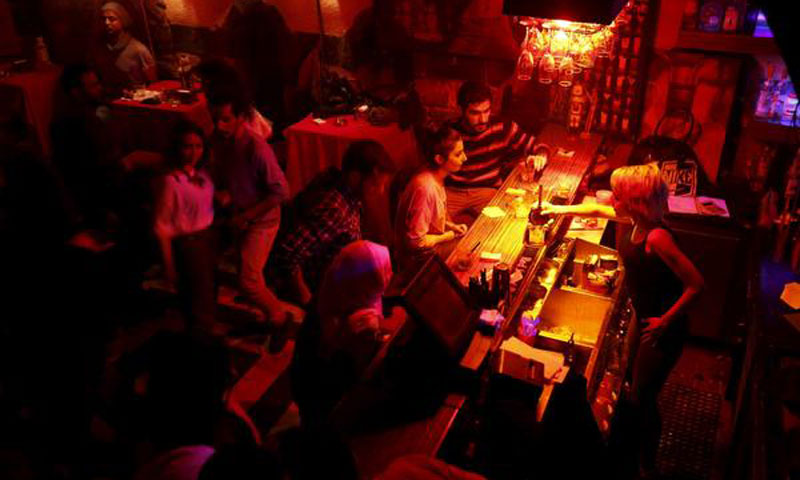



The CNN failed to find a preliminary snapshot of the war in Syria in its archive and did not find what could be in contrast with the reality it had seen in Syria. So, it replaced it with an archived record of the media office in the Sham Legion and another bearing the slogan “Aleppo media office,” to start its report on “another aspect of life in Syria.”
Clean beaches, women wearing bikinis, alcoholics, young men who speak fluent English are all “amazing” pictures which the writer of the CNN report, published in mid-August, sought to express in an “enthusiastic” way, along with other pictures of night clubs and dance parties in Latakia.
The international media networks talk about the “Secular Syria” in the areas under the regime’s control versus the “Extremist Islamist Syria” which is controlled by the opposition factions, in a direction that the Syrian regime sought to strengthen by attracting the delegates of these institutions and allowing them to take photos in Syria, after being accompanied by “tour guides” who are actually security officers and officials of the Lebanese Hezbollah.
BBC Arabic, which belongs to the famous BBC, has been able to maintain its presence in Damascus during the last six years, through its correspondent Assaf Abboud, who appeared to be close to Al-Assad forces and several government agencies, so that the channel and its website held an unclear attitude about the regime’s policies towards opposition-held areas.
The “unclear attitude” has “gladly” obeyed “the Damascene night life” and documented a new industry that had not been previously part of Syria’s production plans and was not a very reliable part of the imports of a country dominated by conservative social customs.
“The entertainment and leisure industry” was what drew the attention of the BBC’s correspondent in Damascus, Omar Abd Al-Razaq, when he looked for a social aspect that he could document in a city which suffers from deteriorating economic conditions and declining levels of services. He was able to discover how much profit the industry could make to its producers and the amount of satisfaction it provides to customers.
Although the majority of Damascus neighbourhoods have not been destroyed, unlike the neighbourhoods close to the eastern Ghouta or the southern neighbourhoods, the real situation in Damascus is not much better than that of other Syrian cities in terms of security restrictions and declining standards of living.
“The new bars have expanded their scope of work, as the tables are in the streets, where alcoholic beverages are served, and the streets and bars are crowded with women and men dancing on Western music,” according to the writer of the report. The latter spoke about the same Damascus which is included in the statistics on unemployment rates and deteriorating economic conditions, where Syria’s average per capita income is no more than $100 US (approximately SYP 50,000), making 80% of the population live below the poverty line.
The cities of Aleppo and Homs also provided the Western press with an important area to search for bright secular features within the “gloomy picture of Syria.” They also created a good advertising platform through which the regime could showcase the “newly created industries in Syria.”
The night atmosphere in Aleppo drew the attention of Western press, which has been quick to praise “the spirit of life in the face of war,” though the documentation of this aspect dates back to the pre-Al-Assad forces’ control of all the neighbourhoods of the city i.e. when the neighbourhoods were thrown with the barrel bombs while others were praised by the Western media for their remarkable “civilization.”
The city of Aleppo, one of Syria’s most devastated cities during the war and which lost tens of thousands of its inhabitants, was able to prove, after the opposition factions leaving at the end of last year, the theory of Western press, which broadcasted the dancing celebrations in the streets of the city, and quoted the “open” ways of expressing joy in the city.
While hundreds of media outlets are banned from entering Syria, the regime seeks to attract media correspondents and popular Western channels, allowing them to travel through Syria to document real life in the areas it controls, including Britain’s Financial Times correspondent Erica Solomon, who started her journey from Damascus to Aleppo through Homs, accompanied by officers of Al-Assad forces, then wrote the “The Three Cities” novel and she was able to discover these cities.
The aspects covered by the Financial Times reporter in addition to the BBC and CNN reporters may not be incompatible with reality, but they do not represent the whole reality. This coverage may be a harbinger of the danger of focusing on creating another image in the minds of Western recipients that hides the image of previous massacres and bombardments with chemical weapons, which means a low degree of enthusiasm in sympathy and willingness to ensure the accountability of those who are involved.
“There is no fire here, only hookah smoke.” As for the unprecedented scale of the destruction in Syria, it is invisible and may be hiding behind the smoke, according to the United Nations, while a BBC reporter could use the sound of the regime’s missiles to enjoy “the rhythm of everyday life in Syria.”
if you think the article contain wrong information or you have additional details Send Correction